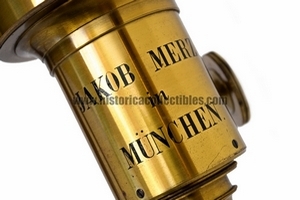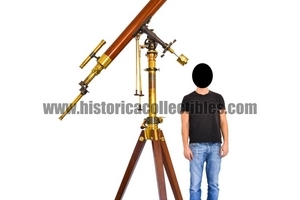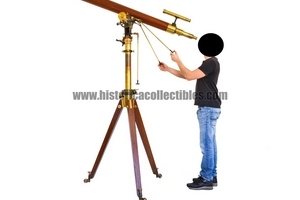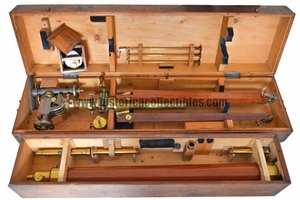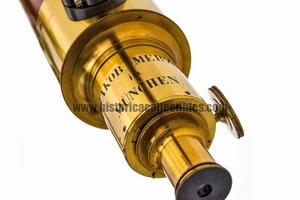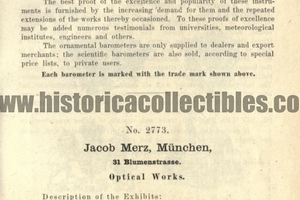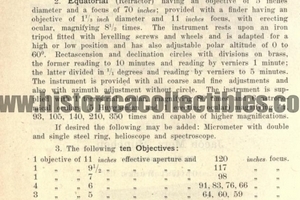Telescope Equatorial Refractor, JAKOB MERZ in Munich, circa 1875
Refractor telescope with Equatorial mount (also called German or Fraunhofer), made up of two axes, orthogonal to each other, which can rotate independently in any direction. Among the most beautiful telescopes produced in the Merz Laboratory are very expensive models, including this model called "Tripod E" or (Parlor Telescope). “Tripod E” was made of polished mahogany and could be adjusted to the desired height using a crank rack.
Made by JAKOB MERZ in München around 1875, considered one of the most prestigious and authoritative European manufacturers of optical instruments dedicated to astronomical and terrestrial observation of that era. Jakob was the nephew of Georg Merz, and consequently the cousin of Sigmund and Ludwig Merz, who shared ownership of the company with their father Georg respectively Ludwig until 1858 when he passed away and Sigmund until 1867 when his father passed away Georg thus remaining the owner.
In 1882 his cousin Jakob acquired total ownership, and then in turn sold it to Paul Tschokke on 5 October 1903.
The optical tube is made of a brass cylinder, covered in fir wood and lined in mahogany, and is equipped with all its original eyepieces, 5 astronomical and 2 terrestrial. It is equipped with its extraordinary brass finderscope, with inside not a simple reticle, but a viewfinder made up of two perforated glass diaphragms, which form a small ring in the center where the star or planet will be placed as an image to be observed. The whole set is preserved in its original solid fir wood case.
As an integral accessory of the telescope, there is a beautiful and complex helioscope or multi-prismatic rotating polarizer with micrometric adjustment, made and signed by Jakob Merz München, perfectly intact and functional, also preserved in its original wooden case.
The mechanical part essential to the assembly and operation of the telescope is made up of the most advanced mechanical technologies of the time.
All the micrometric movements of the Telescope which are carried out to follow the natural motion of the stars, are carried out by means of exceptional leverages with multiple cardan joints, equipped with particular knobs in precious hard wood which enhance the already magnificent overall elements of this instrument observation. Furthermore, the knobs themselves were designed to avoid touching the metal which could become cold if used late at night or at low temperatures.
Both axes are equipped with graduated circles that allow you to point the telescope towards the region of the sky you want to observe based on its astronomical coordinates (hour angle and declination); the two circles are equipped with microscopes for reading the small numbers useful for divisions which are strictly hand engraved on silver rings.
The mechanism composed of gears and rack, useful for activating the elevation of the telescope, is equipped with a beautiful crank to which a particular anti-return braking system is applied.
The extraordinary device for "levelling" the telescope consists of an ingenious quadrilateral tilting mechanism with return, which allows this action to be carried out with surprising speed and precision with the help of two relative bubbles in Strictly original glass, intact and functional.
This marvel of mechanics, completely made of finely laminated solid brass and treated at the time with a particular antioxidant lacquer still integrally present on all the components, is assembled with extreme precision and without any play between the parts subject to movement. It is supported by an exceptional easel made up of three sturdy elements made of solid mahogany, which are equipped with 360° rotating brass wheels (equipped with screw brakes) which allow us to move its considerable weight with extreme ease.
The magnificent easel and the equatorial mount which is an integral part of it, are kept in a single case in solid fir wood with a hinged door opening, equipped with sturdy iron handles suitable for transport.
The conditions of the telescope, the equatorial mount, the tripod and its relative accessories are perfect and absolutely original, as are their relative transport cases.
The technical and optical characteristics of this telescope appear in an important catalog (see photo) relating to the Universal Exposition held in Chicago in 1893, where Jakob Merz participated with resounding success by exhibiting his prestigious production of telescopes.
A wonderful and very rare piece of history that has come down to us intact in all its parts, made by the most renowned European manufacturer of optical instruments, used for scientific, astronomical and terrestrial studies by the most illustrious astronomers and scientists from all over the world.
The name Merz, shown on scientific and optical instruments, was and still is synonymous with unparalleled prestige, especially in the creations of the period in which Jakob was the owner, as he was able to use and implement all the technical knowledge handed down since the times of Joseph v. Fraunhofer.
The fundamental importance of the Merz telescopes in the history of astronomy is easy to explain given that, after more than a century and a half, they are still present and used in the largest observatories around the world.
George Merz
Georg Merz, born on January 26, 1793 in Bichl near Benediktbeuren, initially attended school in the neighboring monastery and helped his father, who was a linen weaver, in the fields in agriculture. When Utzschneider built a factory in Benediktbeuren to produce flint and crown glass for his optical institute, Merz joined there as a worker in 1808. Inspired by one of the padres of the now secularized monastery, Merz studied mathematics and optics with great enthusiasm in his free time. Fraunhofer recognized the young worker's extraordinary talent and appointed him foreman in the optical department in 1818. When Fraunhofer died in 1826, Merz took over management and became director of the optical department. Together with the mechanic Franz Joseph Mahler, he became a partner in 1830 and owner of the institute in 1839. After Mahler's death in 1845, Georg Merz continued to run the institute with the collaboration of his sons Sigmund (1824 - 1908) and Ludwig (1817 - 1860). Since around 1858, G. & S. Merz also adopted the horseshoe stand specified by Oberhäuser in microscope construction and which was widely adopted.
The institute was moved to Munich and the signature was: "G. Merz & Söhne in Munich".
Ludwig Merz died in 1858 at the age of 41 from lead poisoning, which he contracted while making flint glass in Benediktbeuren. Afterwards the institute was called: “G. & S. Merz in Munich”. In 1865, microscopes from Merz together with instruments from Hartnack achieved a resolution that was unmatched at that time. Georg Merz died on January 12, 1867.
Sigmund was now the sole owner of the institute. In 1871 the company had 63 employees and was signed "G. & S. Merz (formerly Utzschneider & Fraunhofer) in Munich". From 1882 the company was managed by Jakob Merz (1833 - 1906) and Mathias Merz (1826 - 1883). The sole owner from 1882, Jakob Merz, sold the traditional company to Paul Tschokke (1853 - 1932) on October 5, 1903.
Because Fraunhofer managed to create achromatic lens combinations in Bediktbeuren and Munich, the company became world-class. The knowledge remained in the company and under Merz it continued to build large refractors for the observatories of Europe until the mid-19th century. As was the case under Fraunhofer's leadership, microscopes were of minor importance and are therefore quite rare.
Joseph von Fraunhofer
Joseph v Fraunhofer was born on March 6th, 1787 as the son of a master glazier in Straubing. After he had worked in his father's business, but his parents died in 1797 and 1798, he went to Munich in 1799 to learn how to make mirrors and ornaments. His strict teacher Philipp A. Weichselberger prevented the young Fraunhofer from attending Sunday school. However, when his master's house collapsed in 1801, Fraunhofer was rescued unharmed and received 18 ducats as a gift from Elector Maximilian who was present, his situation changed. Fraunhofer made the acquaintance of the manufacturer J. v. Utzschneiders, who in turn helped him to attend Sunday school and encouraged him to study further.
In 1806, Fraunhofer joined the "mathematical-mechanical institute of Utzschneider, Reichenbach and Liebherr". In 1807 the optical workshop was relocated to Benediktbeuren and Fraunhofer worked as a calculator and manufacturer of lenses. As early as 1809, the optical department of the institute was under the management of Fraunhofer.
Around 1811, Fraunhofer began to study the refractive index of his glass in detail and discovered the absorption lines in the solar spectrum.
From 1811, Fraunhofer also offered microscopes in the price lists: With a resolving power of 3 microns, the instrument must have had an aperture of around 0.18; this microscope was already characterized by a screw micrometer.
Thanks to his tireless commitment, Fraunhofer became a partner in the institute in 1814 and continued to make outstanding contributions to the construction and development of large refractors. In the price courant of 1816, one or more microscopes appear for the first time alongside a heliometer and comet finder - the offer from the workshops in Munich and Benedictbeurn was also printed in the July/August 1816 issue of the journal for astronomy. In 1817, Fraunhofer was appointed a corresponding member of the Bavarian Academy.
With the relocation of the optical workshop to Munich in 1819, Fraunhofer became a professor and then in 1821 a "visiting" member of the academy. Two years later, in 1823, he was allowed to call himself a salaried professor and curator of the physics cabinet.
The famous Dorpat refractor was completed in 1824 for the Royal Russian Observatory.
Against the advice of his doctors, Fraunhofer did not take it easy in 1825 after suffering from a lung disease. The disease could not be cured and Fraunhofer died of pulmonary tuberculosis on June 7th, 1826 after eight months in bed.
Joseph von Utzschneider
Utzschneider was born in Rieden in 1763. After school he took up law studies in Ingolstadt and completed it with a doctorate.
From 1784 he was in the Bavarian civil service. He became a salt works administrator, director of the polytechnic central school and mayor of Munich.
In addition to the optical and mechanical institute, Utzschneider was also active in various other fields and operated agriculture as well as a leather and cloth factory.
The optical institute was initially located in Munich on the Westermühlbach, near today's Frauenstrasse. In 1807 it was moved to the secularized monastery in Benediktbeuren. A glassworks had been set up here - this should make you independent of importing the glass and the uncertainties associated with it. After Reichenbach left in 1814, the institute was taken over by Fraunhofer and v. Utzschneider directed. Utzschneider founded a mechanical institute in Munich in 1816 with Liebherr and Werner.
Due to the low turnover of his industrial companies in the years 1817/1818 and the collapse of a bank during this time, Utzschneider was forced to sell the Benediktbeuren monastery. The glassworks remained in Benediktbeuren, but the optical institute was moved back to Munich, near the Schwabinger Tor.
The mechanical institute in Munich was dissolved in 1823 when Liebherr left. After Fraunhofer's death in 1826, Georg Merz headed Utzschneider's "Optical Institute of Utzschneider and Fraunhofer". The smelter's glass continued to be produced only for its own use and was not sold as a raw material to other optical companies. In 1839, Merz bought the institute from Utzschneider. A year later, in 1840, von Utzschneider died.
George von Reichenbach
Georg Friedrich Reichenbach was born on August 24, 1771 in Durlach. For financial reasons, his family was forced to move to Mannheim a few years after his birth. There Reichenbach attracted attention as a seventeen-year-old student at the military academy when he built an English-style mirror sextant - he had seen the model for this at the Mannheim observatory.
Through the mediation of Count Rumford, Reichenbach was able to study two years in England, including mechanical engineering with James Watt. Returning to Bavaria, Reichenbach created his first instruments for the forest chamber. He was promoted to the Bavarian artillery foundry and drilling workshop. In 1796 he was appointed captain of the artillery in Munich.
Here he was finally able to realize his technical and entrepreneurial ideas. He built a marble cutting and paper mill near Tegernsee, improved the gun factory in Amberg and optimized the Bavarian blast furnaces and iron foundries. He also rendered outstanding services to the salt works in Reichenhall and Bertechsgaden and was appointed to the royal salt works council in 1808.
A few years earlier, in 1802, Reichenbach founded a mechanical workshop for the construction of scientific instruments together with J. Liebherr. Utzschneider became a partner in 1804 and the company is now called "Mechanical Institute of Utzschneider, Reichenbach and Liebherr". In 1806 Reichenbach founded an optical institute in Munich with von Utzschneider, but in 1807 it was relocated to the glassworks in Benediktbeuren; with Fraunhofer as foreman. After Liebherr had left the Munich Mechanical Institute in 1813 and set up his own business, Utzschneider and Reichenbach were now in charge. In 1814, however, Reichenbach separated from von Utzschneider and set up his own workshop, but continued to source the glass from Utzschneider's and Fraunhofer's smelters.
Reichenbach was awarded the Knight's Cross of the Civil Merit Order of the Bavarian Crown in 1811, combined with personal nobility. In 1826 he received the commander's cross of this order. As a foreign award, he was also awarded the Knight's Cross of the Zähringer Lion Order.
In the spring of 1824, Reichenbach fell while visiting the Augsburg waterworks and suffered an injury from which he never fully recovered and from which he succumbed on May 21, 1826 at the age of only 54. Concerned about Fraunhofer's state of health, with whom Reichenbach was on friendly terms until the end, Reichenbach's death was kept secret from him.

